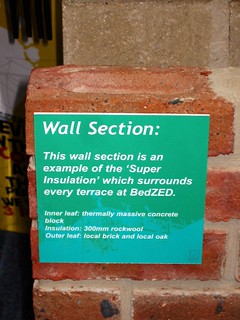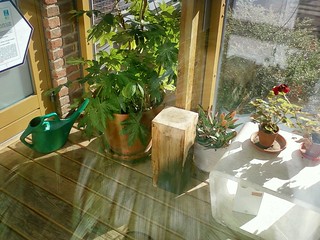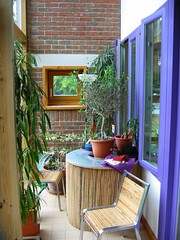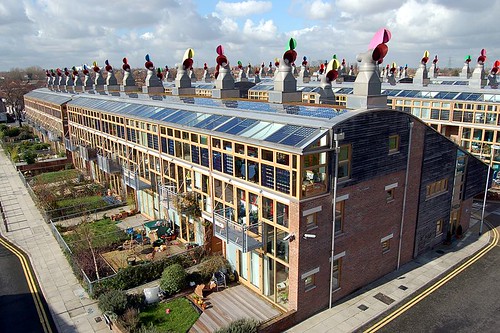London's showcase of sustainable living

Posted July 24, 2012 at 1:28PM
About eight miles or so south of London’s storied Mall, where the Olympic cycling road race will begin and end (look for Mark Cavendish to win), and a little over four miles from Wimbledon where the Olympic tennis will be played (I’m rooting for Roger), there is an interactive exhibit featuring the green aspects of the London 2012 Games. Created by the international sustainability firm BioRegional, the exhibit One Planet Living is being staged at the eco-village BedZED, one of the most interesting and innovative subsidized housing projects one is likely to see anywhere. Here is BioRegional’s description:
“BedZED was the UK’s first large-scale mixed use sustainable community, with 100 homes, office space for around 100 workers and community facilities. Completed in 2002, BedZED is still the inspiration for low carbon neighbourhoods and our One Planet Communities across the world.
“BedZED was developed as a partnership between BioRegional, housing association Peabody and architects ZEDfactory. Residents at BedZED can reduce the carbon emissions of their whole lifestyle by nearly 50%, including energy use in the home, transport and embodied carbon in food and consumer goods. BedZED demonstrates that the 80-90% carbon reductions needed in Europe can be achieved cost effectively, but only if government and business also reduce carbon emissions from services and products.
“Total energy use in the homes is 60% less than for average homes in the local area, photovoltaics supply around 20% of electricity, and a planned new biomass energy plant and off-site renewable energy will mean zero carbon emissions from energy use in the future.”
BioRegional’s headquarters are in the complex, whose name is short for Beddington Zero Energy Development. Apart from a large waste management facility to the east, the community is surrounded by other development and located about a half mile’s walk from Hackbridge Station, which serves trains from Victoria and St. Pancras in central London. The complex, which also enjoys frequent bus service, is about a 15-minute walk in a different direction from tram lines running to Croydon and Wimbledon.
According to the BioRegional site, residents of BedZED enjoy the following:
- Heating energy use 77 percent lower than the local average
- Electricity use 45 percent lower
- Water consumption 58 percent lower
- Driving rate 64 percent below the national average
- Recycling 60 percent of waste
There are also carshare and electric vehicle facilities on site, along with programs for sustainable food.
The Peabody site describes additional green features stemming from BedZED’s architectural choices:
“Where possible, BedZED was built from natural, recycled or reclaimed materials. All wood was approved by the Forest Stewardship Council or comparable internationally recognised environmental organisations, ensuring that it was sustainably sourced.
“Buildings are constructed from thermally massive materials that store heat during warm conditions and release heat at cooler times. The houses are arranged in south facing terraces to maximise heat gain from the sun, known as passive solar gain.”
Peabody owns and manages 20,000 homes in London, including “social housing, leasehold, shared ownership, supported housing, key-worker accommodation and commercial units.“ The organization also provides community job training programs, activities for youth and seniors, welfare benefits advice and family support services. Its history dates to 1862.
BedZED's architecture seems similar to the sort of adaptive reuse of old factories we see in the US, but with the addition of some whimsical shapes and brightly colored utility features that on a different scale evoke those of the Centre Pompidou in Paris. I’m really curious about those chimneys.
The whole project seems impressive to me. It strikes me as the kind of initiative that is bold, ambitious, and conducive to an intentional lifestyle that is perhaps not for everyone, but that will produce information and experience that, over time, will influence more mainstream development. Indeed, this seems already to be happening in the master plan for the Hackbridge neighborhood, where BedZED is located, within the London Borough of Sutton. the plan aims to turn the community "into the UK's first truly sustainable suburb. We have an ambitious vision to make Sutton the greenest place to live, with the flagship Hackbridge project intended as a leading example for the rest of the Borough and the UK to follow."
According to the Borough's website, the detailed plans include proposals for significant green revitalization, including "new eco-friendly homes, more shops, leisure and community facilities, jobs, sustainable transport and pedestrian/ cycle initiatives, improved networks and open spaces." The plan includes green retrofits of existing homes as well as environmental standards for new ones, in order to "enjoy an excellent way of life while using only our fair share of the earth's resources."
Here’s a short video tour of BedZED:
Related posts:
- Do-It-Yourself streets & neighborhood makeover in London (June 1, 2011)
- A living wall in London (May 10, 2011)
- Energy efficiency (including smart growth) is essential to economic recovery (July 7, 2010)
- Vancouver’s medal-worthy Olympic Village, one of the greenest neighborhoods anywhere (February 12, 2010)
- A world-class city at its vibrant best: stunning photographs of London (September 24, 2008)
Move your cursor over the images for credit information.
Please also visit NRDC’s sustainable communities video channels.






